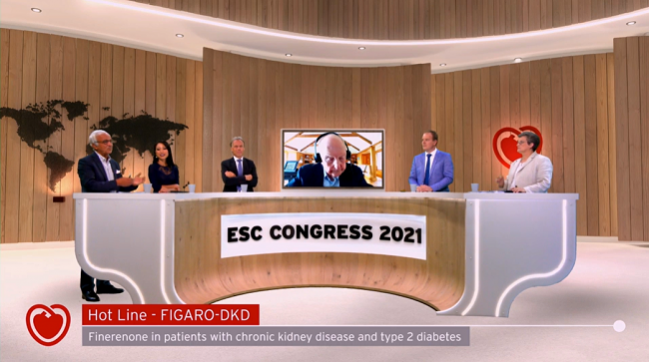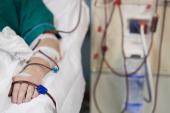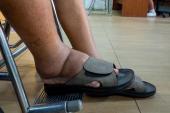Finerenone Reduces CV Outcomes in Patients With Early CKD, Diabetes: FIGARO-DKD
The study, when coupled with FIDELIO-DKD, now opens up finerenone to diabetic patients with a wide range of CKD.

(UPDATED) For patients with type 2 diabetes and mild-to-moderate renal disease, finerenone (Bayer AG) significantly cuts the risk of major cardiovascular events, a benefit largely the result of reductions in heart failure hospitalizations, according to the FIGARO-DKD trial.
The findings, when taken together with the FIDELIO-DKD trial published last year, open up the use of finerenone to a wider group of patients with type 2 diabetes and less severe chronic kidney disease (CKD) who would benefit from using the nonsteroidal, selective mineralocorticoid receptor antagonist (MRA).
“I think we can confidently say that finerenone is effective in type 2 diabetes and across the entire spectrum of renal disease, and I think this is really an advance for our patients,” said lead investigator Bertram Pitt, MD (University of Michigan School of Medicine, Ann Arbor), during a press briefing ahead of the Hot Line presentation at the European Society of Cardiology Congress 2021.
In FIGARO-DKD, which was published simultaneously in the New England Journal of Medicine, 62% of patients had a normal estimated glomerular filtration rate (eGFR) but evidence of renal disease documented by an elevated urinary albumin-creatinine ratio (UACR). “Most of us neglect these patients,” said Pitt. “This is a tremendous opportunity to intervene early with an MRA, finerenone. That’s a really important message.”
Speaking with the media, Pitt said that patients with both type 2 diabetes and CKD have a threefold higher risk of cardiovascular events compared with patients with diabetes alone. Explaining the rationale for the inclusion criteria in FIGARO-DKD, Pitt said that while declining eGFR is known to be associated with higher risks of CVD, increases in the UACR beyond 30 (albumin is measured in mg/creatine measured in g) are also associated with worse CVD outcomes. That association is independent of the eGFR, he stressed.
“The diabetologist certainly knows when they see somebody with diabetes to get a urine sample and to check for albuminuria,” said Pitt. “I’m not so sure that my friends in cardiology, or internists, are as rigorous. When we see a normal eGFR, we just say, ‘That’s OK, goodbye.’ But what we know from this and other studies is that it’s essential to get a urine sample. If they have albuminuria, that patient has an increased risk and now we know that we can do something about it—that patient should be started on therapy.”
Dipti Itchhaporia, MD (Hoag Memorial Hospital Presbyterian, Newport Beach, CA), president of the American College of Cardiology, said cardiologists wouldn’t routinely calculate the UACR, but that the interesting takeaway from this study is there’s value in doing so. FIGARO-DKD, she added, emphasizes the importance of intervening early in diabetic patients with mild-to-moderate CKD to help prevent the progression to heart failure.
“It’s part of the entire cardiorenal connection—we want to decrease inflammation, decrease fibrosis, decrease remodeling,” said Itchhaporia. “That’s probably what this is all about. Now that we have gotten comfortable with SGLT2 inhibitors and that they’re renal-protective, this is just another class of drug that can potentially offer an additional layer of protection.”
Regarding the primary CVD endpoint, Itchhaporia said that while cardiologists would always like to see a survival benefit with treatment, the reduction in heart failure hospitalizations is clinically meaningful. “In chronic disease, heart failure hospitalization reduction is an important endpoint because it’s about quality of life,” she said. “That’s also important for these patients.”
The FIGARO-DKD Trial
Last year, investigators published the results of the FIDELIO-DKD trial, a study of finerenone in patients with predominantly stage 3 or 4 CKD with severely elevated albuminuria and type 2 diabetes. For those patients, treatment with finerenone reduced the risk of the primary endpoint, a composite that included various renal endpoints, including kidney failure, a sustained decrease in eGFR, and renal death. In terms of CVD endpoints, finerenone also reduced the composite endpoint of CV death, hospitalization for heart failure, nonfatal MI, and nonfatal stroke.
In FIGARO-DKD, investigators included patients with a UACR ranging from 30 to less than 300 and an eGFR of 25 to 90 mL per minute per 1.73 m2 of body surface area (stage 2 to 4 CKD). In addition, they included patients with a severely elevated UACR (ranging from 300 to 5,000) but who had a normal eGFR of at least 60 mL per minute per 1.73 m2 (stage 1 or 2 CKD).
In total, 7,437 patients with CKD and type 2 diabetes were randomized to finerenone or placebo and followed for a median of 3.4 years. For the primary endpoint of CV death, nonfatal MI, nonfatal stroke, or hospitalization for heart failure, there were 458 events in those treated with finerenone (12.4%) and 519 in the placebo group (14.2%). This translated into a statistically significant 13% lower risk among those treated with finerenone, a benefit that was driven by a reduction in hospitalizations for heart failure (HR 0.71; 95% CI 0.56-0.90).
With respect to renal outcomes, there was a trend toward a reduction in the risk of kidney failure, a sustained decrease from baseline of at least 40% in the eGFR, or death from renal causes (HR 0.87; 95% CI 0.76-1.01). For the renal events, the researchers also investigated outcomes using the sustained decrease from baseline of at least 57% in the eGFR, which Pitt said is a “more stable and sensitive endpoint” used in other trials. Using that measure of change in eGFR, the composite endpoint was statistically reduced with finerenone.
“Really, what’s important for our patients is that we significantly reduced the need for dialysis and the progression to end-stage renal disease,” Pitt told TCTMD. “I think that’s really what counts for our patients. You can argue about which renal endpoint [to use], but the bottom line is that when you have less progression to end-stage renal disease and dialysis, you’ve really done something worthwhile.”
In total, 10.8% of patients treated finerenone developed hyperkalemia compared with 5.3% of patients in the placebo arm, but just 1.2% of patients stopped finerenone due to hyperkalemia (vs 0.4% in the placebo arm). “This drug is really efficacious and well tolerated,” said Pitt.
Quality of Life
As the discussant during the Hot Line session, Kevin Damman, MD (University Medical Center, Groningen, the Netherlands), highlighted the residual risk of participants in FIGARO-DKD, noting that roughly 15% of the placebo-treated patients experienced an adverse CVD event during follow-up. “To me, more importantly, these patients also have a pronounced decline in eGFR, which was five to six times faster than the general population,” he said. “Clearly, there is an unmet need and we can do better in these patients with diabetes.”
Damman noted that the number of renal events in FIGARO-DKD was approximately half that seen in the FIDELIO-DKD, and the fewer events, likely because patients had less severe renal disease upon study entry, might explain the absence of benefit on the primary renal endpoint.
Gerasimos Filippatos, MD (Attikon University Hospital, Athens, Greece), who reported combined patient-level data from FIGARO-DKD and FIDELITY-DKD in the same Hot Line session, pointed out that 45% to 50% of patients in the trials had a history of cardiovascular disease.
“So, these patients are being seen by cardiologists,” he said. “When we see a patient with a history of myocardial infarction and an eGFR above 60 [mL/min/1.73 m2], I don’t think we thought we should ask for a urinary measurement of albuminuria. In the past, we couldn’t answer the question—so what if we measure it? Now we have answer. . . . We have a treatment that could improve cardiovascular outcomes and also decrease renal progression and end-stage kidney disease. That’s the important [message] for cardiologists.”
To TCTMD, Kurt Huber, MD (Sigmund Freud University Medical School, Vienna, Austria), agreed that FIGARO-DKD emphasizes the need to check for albuminuria in patients with normal eGFR as it will help identify the diabetic patient with mild-to-moderate CKD who might benefit from early treatment with finerenone.
“I think it’s really important,” he said. “I can tell you, as an interventional cardiologist, in my department we treat mostly patients with progressed disease. Patients who’ve received a stent or have had a myocardial infarction, up to 60% of them have diabetes and a relatively high percentage of them also are beginning to show signs of kidney disease. I would say that this is extremely important that we have this data as interventional cardiologists—I think it’ll change our clinical routine within the next few weeks or months based on these data.”
Combining FIGARO-DKD and FIDELIO-DKD
The prespecified patient-level meta-analysis combining FIGARO-DKD and FIDELIO-DKD included 13,171 patients with type 2 diabetes, of whom 40% had preserved kidney function as defined by the eGFR ≥ 60 mL/min/1.73 m2 but elevated UACR.
In FIDELITY, which is the name of combined analysis, finerenone reduced the relative risk of the composite cardiovascular outcome—cardiovascular death, nonfatal MI, nonfatal stroke, or hospitalization for heart failure—by 14% compared with placebo (P = 0.0018). In terms of renal outcomes, there was a relative 23% reduction in the composite renal endpoint—time to kidney failure, sustained ≥ 57% decrease in eGFR from baseline, or deaths from renal causes—with finerenone (P = 0.0002).
With respect to the accumulating evidence base for diabetic patients with CKD, Filippatos highlighted the recent DAPA-CKD trial, which showed the sodium-glucose cotransporter 2 (SGLT2) inhibitor dapagliflozin (Farxiga; AstraZeneca) was more effective than placebo for reducing the risk of the composite endpoint of a sustained decline in the eGFR of least 50%, end-stage renal disease, and death from renal or cardiovascular causes. In that trial, however, only patients with an eGFR of 25 to 75 mL/min/1.73 m2 and a UACR of 200 to 5,000 were eligible for participation. In CREDENCE with canagliflozin, entry criteria were similar, as was the beneficial reduction in adverse renal and cardiovascular outcomes.
Filippatos suspects that patients with type 2 diabetes and CKD will require treatment with both an SGLT2 inhibitor and finerenone. In FIGARO-DKD, however, just 8.4% of patients were treated with the drugs, so future studies will be needed to study the effects of concomitant treatment.
Itchhaporia said one of the questions that remains to be answered is whether treatment with finerenone provides an incremental benefit in diabetic patients with CKD and heart failure who are optimized on medical therapy. In that setting, SGLT2 inhibitors have found a place in clinical practice, but she also believes finerenone will eventually be used as an add-on therapy.
Both FIGARO-DKD and FIDELIO-DKD excluded patients with heart failure, given that MRAs are a class IA indication for patients with NYHA II-IV heart failure with reduced ejection fraction and persistent symptoms. Filippatos suspects that patients with type 2 diabetes and CKD will ultimately require treatment with both an SGLT2 inhibitor and finerenone. Just 8.4% of patients in FIGARO-CKD were treated with an SGLT2 inhibitor, so future studies will be needed to study the effects of concomitant treatment.
Pitt said that while the numbers were small, finerenone worked equally well in those taking an SGLT2 inhibitor, as well as in the majority who were not. There is preclinical data, he added, suggesting finerenone added to empagliflozin (Jardiance; Boehringer Ingelheim/Eli Lilly) had an additive effect on inflammation and fibrosis. “Our expectation is if we were to do those trials, we would see this,” he said. “We can’t say that from our data. . . . It’s something for the future, but all of our expectations—based on the preclinical data and from the trends—[are that] people should be on both.”
Michael O’Riordan is the Managing Editor for TCTMD. He completed his undergraduate degrees at Queen’s University in Kingston, ON, and…
Read Full BioSources
Pitt B, Filippatos G, Agarwal R, et al. Cardiovascular events with finerenone in kidney disease and type 2 diabetes. New Engl J Med. 2021;Epub ahead of print.
Filippatos G. The importance of screening for albuminuria to prevent CV disease in patients with CKD and type 2 diabetes. Presented at: ESC 2021. August 28, 2021.
Disclosures
- Pitt reports consulting for and/or holding stock options in AstraZeneca, Bayer, Boehringer Ingelheim, Brainstorm Medical, Cereno Scientific, G3 Pharmaceuticals, KBP Biosciences, Lexicon Pharmaceuticals, PhaseBio, Proton Intel, Sanofi/Genzyme, Sarfez, scPharmaceuticals, SQ Innovation, Tricida, and Vifor Pharma.
- Filippatos reports serving on the steering committee for Amgen, Bayer, Boehringer Ingelheim, and Medtronic. He reports lectures fees from Novartis and serving as a registry committee member for Servier and on an endpoint review committee for Vifor Pharma.
- Huber reports lecturing and consulting for Amgen, AstraZeneca, Bayer, Boehringer-Ingelheim, Bristol-Myers Squibb, Daiichi Sankyo, Eli Lilly, Novartis, Pfizer, and Sanofi Aventis.





Comments